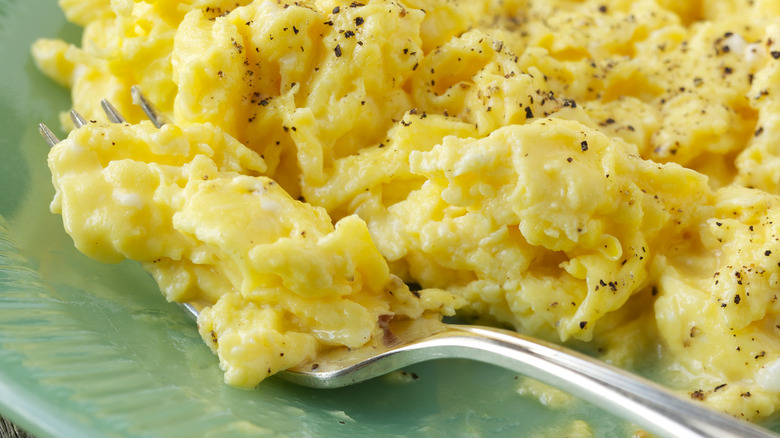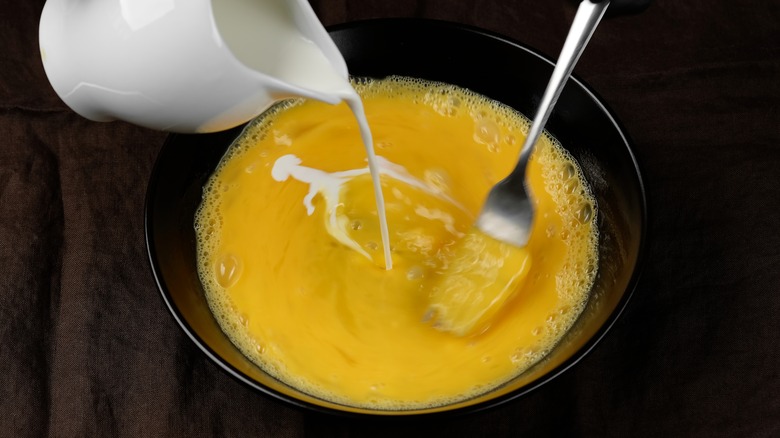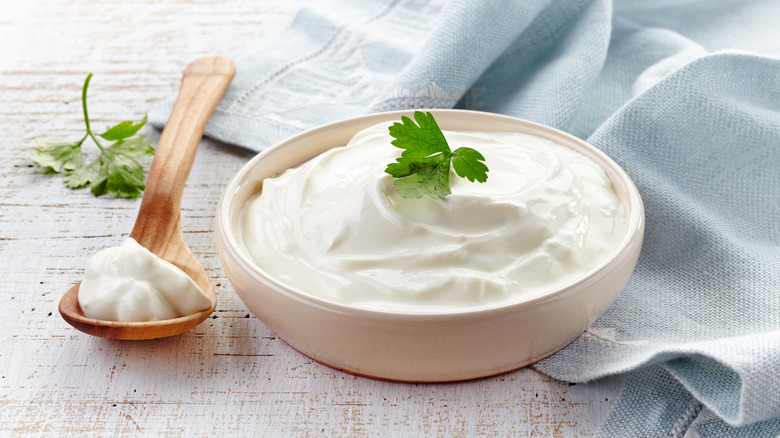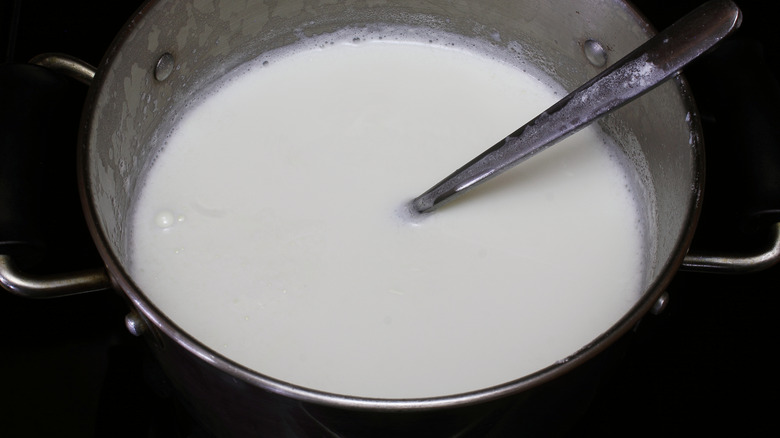Why You Should Be Adding Cream Instead Of Milk To Scrambled Eggs
One of the quickest ways to get a tasty protein boost to carry you through your morning is to whip up a fluffy batch of scrambled eggs. Everyone has their own unique way of preparing them, splashing the pan with savory sauces, mixing in colorful veggies, or kicking the flavor up a notch with some spice. If you want to avoid flat scrambled eggs and elevate the texture of this classic breakfast dish, you might be tempted to reach for milk to add to your recipe. For some, it's considered a cooking sin due to the watery, rubber-like consistency milk tends to contribute. So you might want to consider choosing a thicker dairy product and add cream to your scrambled eggs instead.
For such a simple dish, the number of factors that go into cooking scrambled eggs can make it a finicky job. Even if you've mastered your stirring technique, perfected your heat regulation, and acquired the freshest eggs you could find, one wrong step could make all the difference. Milk can dilute the flavor of scrambled eggs, but adding crème fraîche or heavy whipping cream can bring out the depth of flavor you're trying to achieve. Additionally, milk is known for turning scrambled eggs into chewy chunks, while cream does a better job of holding everything together nicely.
Creamy scrambled eggs absorb moisture better than a milky batch
Of course, everyone has their preferences. If mom always added milk to your eggs, that might be what you're most comfortable with. Or maybe you're a fan of mushy eggs and don't mind the texture. Whatever you prefer, TastyOz on TikTok has got it down to a science, experimenting with different cooking methods, heat levels, and ingredients to see what works and what doesn't.
Out of all their secrets for making the best scrambled eggs, one of them includes adding cream versus milk. They explain that "Milk will alter the structure of your eggs completely," and show moisture escaping from the eggs rather than being absorbed. When they add cream to the pan, the moisture holds better and gives them that sought-after, perfectly fluffy texture, along with a richer taste. The comments are a mix of skeptics, unshakable fans of Gordon Ramsay's scrambled egg recipe, and others offering their own tips. "Add cream in the pan when the eggs are 90% done," suggests one user, while others add that bacon grease, oyster sauce, or plain old water are their go-to add-ins.
The sky's the limit for this versatile breakfast staple.
Add cream at the very end to prevent overcooking scrambled eggs
Not only does adding cream to scrambled eggs give them a more luscious texture than milk, but it can also keep you from overcooking them. When it comes to scrambled eggs, time is of the essence. You can cook them slowly on low heat if you're willing to stand there, stirring frequently until you've got the perfect fluffy final product. But you still might find the eggs are overcooked by the time you get them to your plate and start eating — no matter how you like your eggs cooked. Luckily, the French have a secret to save your scrambled eggs: You can add a cold dollop of cream or mix in a little touch of luxury with some crème fraîche. Introducing the cream to your scrambled eggs at the very end will quickly lower the temperature and halt the cooking process. Once you've reached a texture you're happy with and remove the eggs from the stovetop, the eggs still have some heat locked inside their pillowy layers. Carryover cooking is what's occurring to your eggs at this point — they're still being cooked all the way to your breakfast plate.
Adding cream at the end of the cooking process fixes this issue. It's a well-established French technique that is described by culinary writer and chef Auguste Escoffier, who wrote "Le Guide Culinaire" in the early 1900s. The century-old approach is described as an "unalterable" method, in which the cold creamy element should be added once the eggs take on a slightly thickened, custard-like consistency. This can be done with sour cream, heavy cream, and even yogurt.
Simmering the cream adds a hint of sweetness to eggs
If you're not a fan of strategically adding a boost of flavor with the best spices and herbs for scrambled eggs and prefer a hint of sweetness, heavy cream is a good way to go. J Kenji López-Alt takes the whole process further by experimenting with "frying" the scrambled egg mixture in cream. This requires just the right amount of cream, cooked just for a brief time, to avoid tough lumpy eggs. He starts by carmelizing a small dab of butter and adds the cold cream to that to cool it down. Then he drizzles the mixed eggs in ribbons into the cream, finishing with the familiar dash of cold dairy. "I ended up with creamy, nongreasy ribbons of egg with the nutty flavor of browned butter," he explained in a New York Times article.
The caramelized butter and the cream bring out a rich sweetness that turns scrambled eggs into a real treat that would make any breakfast-lover raise their eyebrows in pleasant surprise. Though the recipe starts with heavy cream, don't forget the "unalterable" step of adding more cream at the end to avoid overcooking.



